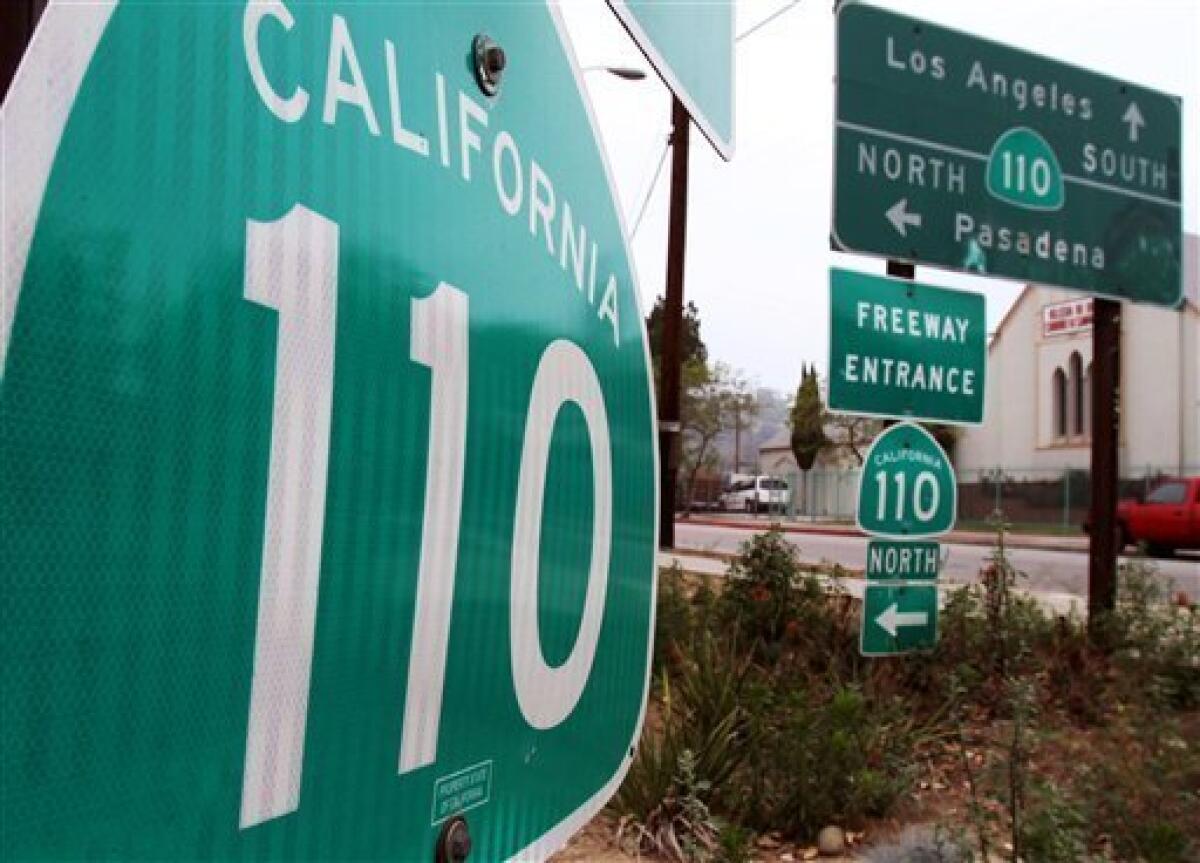Preservationists: Don’t change West’s 1st freeway

You don’t typically hear Southern Californians rhapsodize about a freeway.
But the 8.2-mile route between downtown Los Angeles and suburban Pasadena isn’t typical.
Opened in 1940, the oldest freeway in the West follows the meanders of the Arroyo Seco wash past parks and lush embankments, and under bridges and through tunnels built with the elegance of a bygone era.
Known variously as the Arroyo Seco Parkway, the Pasadena Freeway or simply “the 110,” it also carries motorists past some of the city’s oldest - and toughest - neighborhoods as its tight curves open and close views of mountain peaks and downtown skyscrapers.
Squinting to shut out thoroughly modern gang graffiti and the mangled plastic debris of 21st century auto mashups, it’s still possible to envision a Ford Model A wending its way to Los Angeles or a stately General Motors LaSalle carrying an oil baron home to one of the old school mansions of Pasadena.
That’s why preservationists are crying foul over the freeway’s first major improvement project in 70 years, a $17 million effort to line the original six miles of the route with new concrete barriers and lighting.
They complain that the work will remove historic features that define its character and that the additions don’t have a sufficiently authentic appearance.
“The Arroyo Seco Parkway is a real gem. I don’t think people fully appreciate that yet and I think they’ll regret the damage that’s being caused,” said Paul Daniel Marriott, author of “Saving Historic Roads.”
The route represents a transitional period in American highway construction when planners were moving away from the parkways popularized on the East Coast for leisure driving to building roads for high-speed, efficient travel, Marriott said.
Its design melded lush landscaping with six lanes allowing commuters to reach speeds of 45 mph.
Many of its elements became prototypes for the modern freeway, so much so that by the 1950s, when Los Angeles was emerging as a car capital, the parkway’s name evolved to the Pasadena Freeway.
“This is where we come from, this is where our freeways evolved from,” said Nicole Possert, a community activist leading the preservation effort. “This was a testing ground for what was to become the California freeway system.”
The California Department of Transportation began late last year to replace metal beam guardrails on wooden posts with concrete barriers for safety and to reduce maintenance costs.
Caltrans said the upgrades were crucial to prevent out-of-control vehicles from plunging into the Arroyo Seco, a watercourse that carries storm runoff from the San Gabriel Mountains to the Los Angeles River.
Balancing the need to retain the freeway’s historic features while trying to bring it up to modern highway standards has been one of the department’s biggest challenges.
A drive on the freeway can be frightening or suggest Grand Prix racing. Lanes are narrow, there are no shoulders, and many entrances and exits are sharp right turns with little time for merging or braking. There are only occasional short turnouts for changing a tire or waiting for a tow.
The parkway was originally built to carry 27,000 vehicles a day. By 2008, it carried an average daily traffic load of 125,000 cars. Trucks are banned.
A 2005 study found it had the highest accident rate compared to eight other freeways in the metropolitan area, most of them caused by speeding drivers.
“On this route there’s little patrolling by the police because of the lack of shoulder space, all that means is more speeding and more accidents,” said Anastasia Loukaitou-Sideris, a professor of urban planning at the University of California, Los Angeles who co-authored the study.
Fixing a guardrail after a crash requires closing a lane, causing traffic to back up for miles.
Caltrans said replacing guardrails with concrete barriers will lower maintenance costs from $800 to $80 per kilometer (.62 mile) of barrier, will take less time to repair and therefore won’t impede traffic.
The changes are welcomed by Radolfo Torres, who has lived next to the southbound lanes for 30 years and has jumped over the chain link fence numerous times to rescue people involved in accidents.
“There’s no room to widen the road, and you can’t straighten it either. This is better than doing nothing,” Torres said.
But preservationists say the side barriers, which feature patterns simulating the stonework architecture in historic communities along the route, don’t look like the real deal and will serve as canvasses for taggers.
New lampposts, designed to look old while offering improved road lighting, aren’t replicas of the kinds that used to line the parkway 70 years ago, they said.
“Why was the style of the original lamps not respected or preserved? Why does it have to be some phony thing?” said Martha Benedict, a community activist.
Opponents also decry the removal of a center median curb that is an original feature. The curb, which in some places has indentations pointing in the correct direction of travel, was considered one of the parkway’s many novel design features when it was named a National Historic Civil Engineering Landmark in 1999.
Preservationists say the curb, while little noticed by speeding commuters, is as much a character-defining feature of the old parkway as the many sycamore trees, Art Deco tunnels, and old-fashioned bridges and train trestles.
Caltrans contends the curb must be removed to comply with current construction standards.